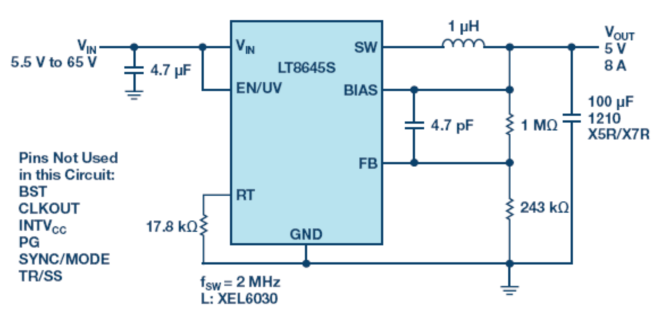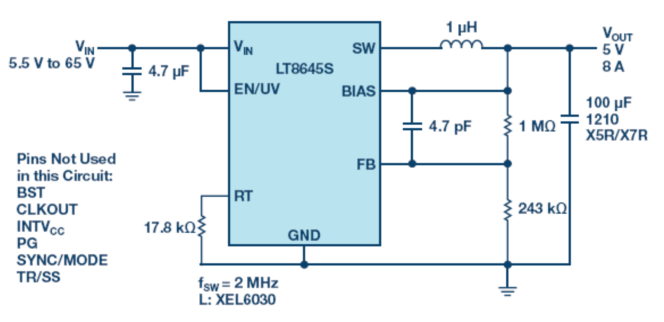May 31, 2021
2451
Generally speaking, ADAS integrates some microprocessors to collect all the inputs provided by the many sensors in the car, and then process them so that they can be presented to the driver in a convenient and understandable manner. In addition, these systems are usually directly powered by the vehicle's main battery, with a nominal voltage of 9V to 18V, but due to voltage transients inside the system, the voltage may be as high as 42V, and during a cold start, the voltage may be as low as 3.4V. Therefore, any DC-DC converter in these systems must be able to handle a wide input voltage range of at least 3.4V to 42V. In addition, many dual-battery systems (such as those commonly found in trucks) require a wider input range, and the upper limit is pushed up to 65V. Therefore, some ADAS manufacturers design their systems to cover an input range of 3.4V to 65V, making it usable in cars or trucks, while obtaining the benefits of economies of scale in the manufacturing process.
Most ADAS use 5V and 3.3V power rails to power their various analog and digital IC devices. Accordingly, manufacturers of such systems prefer to use a single converter to solve both single-battery and dual-battery configurations. In addition, the system is usually installed in a part of the vehicle where space and heat dissipation are restricted, which will limit the radiator used for heat dissipation. Although it is commonplace to use high-voltage DC-DC converters to directly generate 5V and 3.3V power rails from the battery, in today's ADAS, the switching regulator must also achieve a switching frequency of 2MHz or higher instead of the previous 500kHz operating frequency. The key driving force behind this change is the need for a smaller size solution while also staying above the AM frequency band to avoid any potential interference.
In addition, as if the designer’s task is not complex enough, they must also ensure that the ADAS meets the various noise immunity standards in the car. In the automotive environment, switching regulators are replacing linear regulators in areas where low heat generation and high efficiency are important. Moreover, the switching regulator is usually the first active component on the input power bus, so it has an important impact on the EMI performance of the entire converter circuit.
There are two types of EMI emissions: conducted and radiated. Conducted emissions are located on the wires and traces connected to the product. Since this noise is limited to specific terminals or connectors in the design, it is usually relatively easy to ensure compliance with conducted radiation requirements with the help of a good layout or filter design during the development process.
However, radiation emission is another matter entirely. Anything on the circuit board that carries current will radiate electromagnetic fields. Each trace on the circuit board is an antenna, and each copper layer is a resonator. In addition to pure sine waves or DC voltage, anything else will generate noise in the entire signal spectrum. Even with careful design, before the system is tested, the power supply designer does not really know how bad the radiated emission will be-and the radiated emission test can only be officially carried out after the design is basically completed.
Filters are often used to attenuate the signal strength of a specific frequency or a certain frequency range, thereby reducing EMI. This part of the energy that travels through space (radiation) can be attenuated by adding metal and magnetic shielding. The part of the energy located in the PCB trace (conduction) can be suppressed by adding ferrite beads and other filters. EMI cannot be eliminated, but it can be attenuated to a level acceptable to other communications and digital devices. In addition, many regulatory agencies have implemented relevant standards to ensure product compliance.

Figure 1. Schematic diagram of LT8645S with 5V, 8A, 2MHz output
Modern input filters use surface mount technology to have better performance than through-hole devices. However, this improvement cannot keep up with the increase in the operating frequency of the switching regulator. Higher efficiency, shorter on/off times and faster switching transitions result in higher harmonic content. When all other parameters (such as switching capacity and conversion time) remain the same, each time the switching frequency doubles, EMI will deteriorate by 6dB. If the switching frequency is increased by a factor of 10, broadband EMI will be like a first-order high-pass filter with a 20dB increase in radiation.
Experienced PCB designers will make the thermal loop smaller and keep the shield ground layer as close as possible to the active layer. Nevertheless, the device pinout, package structure, heat dissipation design requirements, and the package size required to store sufficient energy in the decoupling component all require a certain minimum size thermal loop. To complicate matters, in a typical flat printed circuit board, magnetic or transformer coupling between traces above 30MHz will weaken the effect of all filters, because the higher the harmonic frequency, the more significant the bad magnetic coupling.
High voltage DC-DC converter with low EMI radiation
In view of the application limitations mentioned above, the PowerbyLinear™ division of Analog Devices developed the LT8645S-a synchronous step-down converter that supports high input voltage, single chip, and low EMI radiation. Its input voltage range is 3.4V to 65V, so it is suitable for both automotive applications and truck applications, including ADAS, which must be competent for regulation in cold start and start-stop scenarios. The minimum input voltage is as low as 3.4V, and the power is cut off transient More than 60V. As shown in Figure 1, the device uses a single-channel design to provide 5V, 8A output. When the switching frequency is 2MHz, its synchronous rectification topology can achieve up to 94% efficiency, and under no-load standby conditions, BurstMode® keeps the quiescent current below 2.5μA, so it is very suitable for always-on systems. .
In the entire load range, LT8645S can easily meet automotive CISPR25, Class5 peak EMI limits. Spread spectrum frequency modulation can also be used to further reduce EMI levels (Figure 2). The LT8645S has built-in high-efficiency top and bottom power switches, and integrates the necessary boost diodes, oscillators, and control and logic circuits into a single chip. The low-ripple burst operation mode can maintain high efficiency at low output current while keeping the output ripple below 10mVp-p. Finally, the LT8645S is packaged in a small thermally enhanced 4mm×6mm, 32-pin LQFN package.

Figure 2. LT8640S radiated EMI performance graph
In conclusion
The promotion of ADAS in the car and truck market will not end soon. It is also clear that finding the right power conversion device to meet all the necessary performance indicators so as not to interfere with ADAS is not a simple task. Fortunately, designers of such automotive systems can now get the powerful performance and capabilities provided by ADI's SilentSwitcher2DC-DC converter. These devices not only greatly simplify the work of power supply designers, but also provide all the performance they need, without requiring complex layout or design techniques.